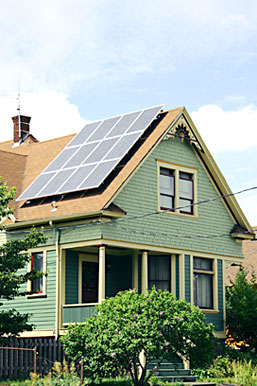Consumers Energy adds more solar projects to its renewable pilot program
 Michigan’s Consumers Energy is adding small-scale solar projects in 14 counties as part of its Experimental Advanced Renewable Program (EARP) feed-in tariff program. The program will consist of 20 projects at homes and small businesses across the utility’s service area that will receive a tariff for their generation rather than a standard net-metering contract with the utility.
Michigan’s Consumers Energy is adding small-scale solar projects in 14 counties as part of its Experimental Advanced Renewable Program (EARP) feed-in tariff program. The program will consist of 20 projects at homes and small businesses across the utility’s service area that will receive a tariff for their generation rather than a standard net-metering contract with the utility.
The program is part of a larger 5 megawatt program to add more solar installations into Consumers Energy’s supply mix, as required under Michigan law, according to Consumers Energy spokesperson Dan Bishop. The most recent phase of the program, Phase 7, will support 20 projects across the state, ranging in size from 1.3 kilowatts to 15 kilowatts. The projects will receive 24.9 cents per kilowatt hour produced by their systems, according to the Database of State Incentives for Renewables and Efficiency (DSIRE). The company will accept applications for two more phases of the EARP program later this year.
“There’s a law in Michigan that requires all utilities to have 10 percent of power from renewable sources. We’re required to get to 10 percent by 2015,” Bishop said. “We’re at about 5 percent now in terms of the electricity we provide to 1.8 million customers.”
Since Michigan doesn’t have the solar resources of California, Arizona or even New Jersey, it’s been slower to catch on in the state. In fact, the majority of Consumers Energy’s new renewable resources will consist of wind, biogas and hydro, according to Bishop. For instance, it’s building out its first wind farm, the 100 megawatt Lake Winds Energy Park in Mason County. It will also use the power from the 3 MW Fremont Community Digester being developed by Novi Energy. It’s the first biodigester in the state, according to Bishop. “That will take waste food products and turn it into fuel to make electricity,” he said.
The program is still in it’s pilot stage, Bishop said. Before the company can expand it there are still some things that need to be worked out. “We’re learning as we forward with this. Customers are learning, installers are learning. The process is getting more efficient but there’s nothing new to announce at this point,” he said. Customers can also install solar on their homes through the company’s net metering policy, which offers net metering at retail rate for net excess generation and is credited forward on the customer’s bill for a month when they use more than they produce.



